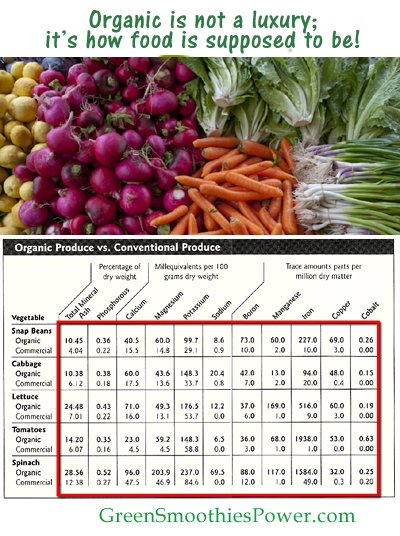Why Buy Organic: Organic Food Contains More Nurtients (Part 2)
In the first part of Why Buy Organic? I talked about the pesticides, herbicides, and other toxic substances that are used to grow conventional produce.
However, toxins in conventional produce is only part of the story. The other important piece, is the amount of nutrients in conventional vs organic produce.
Many people purchase organic food because they believe it is healthier than conventionally grown food. Yet, the organic industry is constantly told that there is no evidence to support these claims. I’ve read on more than one occasion about “research” that “proved” the equal nutritional value of conventional produce when compared with organic.
I don’t believe that at all.
While certainly eating conventional produce is better than not eating plant foods at all, organically produced fruits and vegetables contain much higher amounts of nutrients, and therefore are more nutrition-rich and health promoting, than their conventional counterparts.
And there are numerous studies that prove that.
“Research published in 2001 showed that the current fruit and vegetables in the USA have about half the vitamin content of their counterparts in 1963. This study was based on comparing published US Department of Agriculture (USDA) figures.
A scientific study published in the Journal of Applied Nutrition in 1993 clearly showed that organic food is more nutritious than conventional food.
Organically and conventionally grown apples, potatoes, pears, wheat, and sweet corn were purchased in the western suburbs of Chicago, over two years, and analyzed for mineral content. The organically grown food averaged 63% higher in calcium, 73% higher in iron, 118% higher in magnesium, 178% higher in molybdenum, 91% higher in phosphorus, 125% higher in potassium and 60% higher in zinc. The organic food averaged 29% lower in mercury than the conventionally raised food.
A peer reviewed scientific article published in the February 2003 edition of the Journal of Agricultural and Food Chemistry stated that organically grown corn, strawberries and marionberries have significantly higher levels of cancer fighting antioxidants than conventionally grown foods. Some of these compounds, such as Flavonoids, are phenolic compounds that have potent antioxidant activities. Many are produced in plants in response to environmental stresses, such as insects or competing plants. They are protective compounds that act as a plant’s natural defense and also have protective properties in human and animal health.
The research suggested that pesticides and herbicides disrupt the production of these protective compounds. Good soil nutrition appears to increase the levels of these natural compounds that have anti cancer, immune boosting and anti aging properties.” via http://www.permaculture.com/drupal/node/144
It’s All In the Soil
The main reason for this is the quality of the soil.
If we care about the nutrition that we receive from our food, we absolutely must not ignore the quality of nutrients plants receive from the soil because the quality of the soil in which the plants grow has a huge influence on our health and on the health of the animals that eat those plants.
The soil plants grow in are as important to our health as plants themselves, if not more!
Conventional agriculture ignores the complex ecosystems of the soil and focuses their efforts at supplying potassium, nitrogen and other chemicals to the plants.
Organic farmers, on the other hand, make sure they are feeding the living microorganisms in the soil, which are essential for growing plants that are rich in nutrients and health promoting minerals.

Organic vs conventional produce: Nutrients come from the the soil
Microorganisms in the soil cannot survive when fed artificial fertilizers, and when all microorganisms die because of the overuse of chemicals, the soil turns into dust.
Here is an interesting fact: “the combined weight of all the microbial cells on earth is twenty-five times that of its animal life; every acre of well-cultivated land contains up to a half a ton of thriving microorganisms, and a ton of earthworms which can daily excrete a ton of humic casting.” (Peter Tompins and Christopher Bird “Secrets of the Soil.)
Most of the soil of agricultural farms in the USA contains less than 2% of organic matter, while originally, before the era of chemistry, it was 60-100%.
According to David Blume, an ecological biologist and permaculture expert, “Most Class I agricultural soil is lucky to hit 2% organic matter – the dividing line between a living and dead soil”. By applying permaculture gardening techniques to a field of extremely depleted soil, which consisted of cement-hard adobe clay, David Blume was able to bring the organic matter to the 25% level within just a couple of years. From this field he harvested the crops “8 times what the USDA claims are possible per square foot” via “Green For Life” by Victoria Boutenko
Organic Vs Conventional Nutrition

Organic vs conventional produce nutrition
Solutions are available, and decisions are being made now. I will write about the in the next installment of “Why buy organic?”.

Organic vs conventional produce nutrition; via Green For Life by Victoria Boutenko
Questions? Comments? Suggestions?
If you have a favorite recipe, why not submit it here in the comment section of this smoothie recipes blog for others to enjoy too!
I also welcome any comments, questions and suggestions. Thanks!
